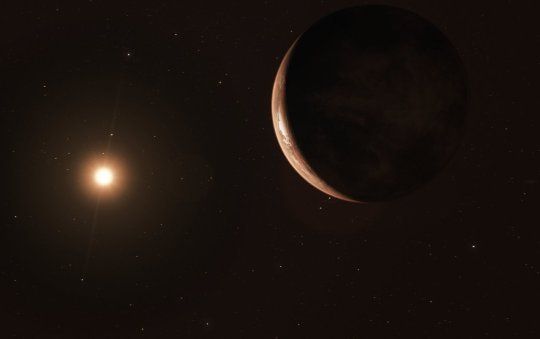The Exoplanet Next Door
by John Wenz (astronomy.com)
• Since first detecting a weak signal from our Sun’s closest neighbor, Proxima Centauri (only 4.24 light-years away) in 2013, a group of astronomers from Germany, France and Chile who call themselves the “Pale Red Dot Team’ have been looking for – and have found – an Earth-mass planet in the habitable zone of that star. Proxima was monitored closely for subtle variations on the European Southern Observatory’s HARPS instrument over a series of nights from January 19 to March 31, 2016. By a process called radial velocity that looks for Doppler shifts in a star’s light due to the tug of a planet, the researchers could estimate the mass and orbital frequency to zero in on a planet, which they named Proxima Centauri b (PCb). Their findings were published in the science journal Nature last summer.
• Turns out that PCb is quite Earth-like. It slightly bigger and is roughly the mass of our planet and is located in just the right “Goldilocks zone” in relation to its star where, if it has an atmosphere, liquid water could exist on the surface. The exoplanet’s distance from its star is only one-fifth the distance from Mercury to the Sun. But Proxima Centauri is only a little larger than Jupiter, considered the runt of the litter in the Alpha Centauri system.
• The reason that the five billion year-old PCb planet revolves so quickly around its star is because it is tidally locked to it. The same side of the planet faces Proxima Centauri at all times, much like the same side of the Moon faces Earth at all times. But if PCb still has an atmosphere, it could reach temperatures up to 86° F (30° C) on its sunlit side, and -22° F (-30° C) on its darker side, bringing it into quite Earth-like temperature ranges. But if, for some reason, PCb has lost its atmosphere, the lack of atmosphere could have evaporated any water on the planet long ago, leaving a cold, barren planet of -40° F (-40° C).
• The key to preserving an atmosphere would be the existence of a magnetic field. Researchers have gone back and forth whether a tidally locked planet could have a core that stirs with its rotation, thus generating a magnetic field. The magnetic field shields the planet from the worst excesses of its star, which then settles into a state of relative dormancy. The Pale Red Dot astronomers believe that as a planet migrates closer to its sun while creating a magnetic field, this magnetic field could remain active even after a planet gets so close to become tidally locked to its sun.
• Astronomers need to observe the planet in greater detail in order to further characterize it. Planets are so small, the signals are so weak, it almost needs its own dedicated telescope. Currently, no instrument in space or on the ground is sensitive enough to pick up reflected light from older and smaller planets. But the James Webb Space Telescope currently under construction might be a mega-telescope that can actually detect biosignatures, or even molecules, in the atmospheres of other planets. Other proposed methods of getting deeper into a planet’s biosignature include ‘stellar suppression’ which blocks the surrounding light of the star, and infrared.
• “To find (a habitable planet) around the nearest, best-studied star … maybe we’re just really lucky, or maybe there really are just billions of M-dwarf planets out there waiting for us to find them,” says Elisabeth Newton, a Kavli post-doctoral fellow at MIT who studies red dwarf, or M-dwarf, systems. Nearly every star is suspected to have a planet. Some of those could be habitable. If it ends up that PCb is barren, then perhaps we’ll have better luck looking at the next star over, Barnard’s Star.
The hunt for exoplanets has, in some ways, been about the hunt for an Earth-like planet – something warm where water could exist. Headlines tout each discovery as “the most Earth-like planet yet.” Many of those planets are far away.
But a new discovery published August 24 in Nature hits closer to home, with an Earth-mass planet in the habitable zone of its star. What’s more, that star is Proxima Centauri, only 4.24 light-years away. That means that there is no solar system that will be closer to Earth in our lifetimes.
And so far, the exoplanet, named Proxima Centauri b, is shaping up to be quite Earth-like, roughly the mass of our planet and in just the right place where, if it has an atmosphere, liquid water could exist on the surface.
This is as in our backyard as it gets.
“I think it actually marks a transition,” Jeffrey Coughlin, a SETI Institute scientist not involved in the study who assembles the Kepler catalog, says. “Twenty years ago, we were finding the first exoplanets and it was totally exciting,” he says. Then there was the Kepler telescope, which found thousands of planets, including some in the habitable zone, and some within a few dozen light-years of us.
And now there’s a planet of 1.3 Earth masses right next door, zipping around its star in 11.2 days. Its distance of 4,349,598 miles (7 million kilometers) from its star may seem tiny, at just one-fifth the distance between Mercury and the Sun, but Proxima Centauri is the runt of the litter in the Alpha Centauri system. At a diameter of 124,274 miles (200,000km), it’s only 1.43 times the diameter of Jupiter.
So how was there a planet hiding around the closest star to us, just waiting to be discovered? The simple answer: Finding a planet is really hard. Kepler found thousands of planets by staring at 145,000 stars in a minute region of the sky at the tail end of Cygnus, waiting for the 1 percent chance a planet would directly pass in front of a star and cause a dip in its light, in a method known as transiting.
But the problem with the Proxima Centauri planet is that it doesn’t transit — at least not from our vantage point. In order to witness a transit, the orbital plane of the planets must be at or near our line of vision, but not all solar systems have the same orientation. A star might have all of its planets aligned at a 90-degree angle from us, with the planets orbiting in such a way that they never pass in front of their star for our telescopes to see. While some planets have been found by direct imaging (that is, appearing in a photo along with its star) it’s not possible of yet with Proxima, a 5 billion year old planet. Unless the planets are very young and very large, no instruments are currently capable of directly imaging these planets.
How to find a planet (that doesn’t want to be found)
That’s why the Pale Red Dot project, tasked with finding a planet around our nearest neighbor, had to turn to indirect — but reliable — methods of detection. The researchers chose radial velocity, a process that looks for shifts in a star’s light due to the tug of a planet, sometimes called the Doppler shift method. Subtle movements of gravity cause the light of a star to move toward the blue end of the light spectrum, which means it’s moving toward us, or the red end of the spectrum, which means it’s moving away. Based on those changes, researchers can give a mass estimate, and the frequency gives an idea of the orbit.
The planet itself was found over a series of nights from January 19 to March 31, 2016, during which Proxima was monitored closely for subtle variations on the European Southern Observatory’s HARPS instrument.
FAIR USE NOTICE: This page contains copyrighted material the use of which has not been specifically authorized by the copyright owner. ExoNews.org distributes this material for the purpose of news reporting, educational research, comment and criticism, constituting Fair Use under 17 U.S.C § 107. Please contact the Editor at ExoNews with any copyright issue.

